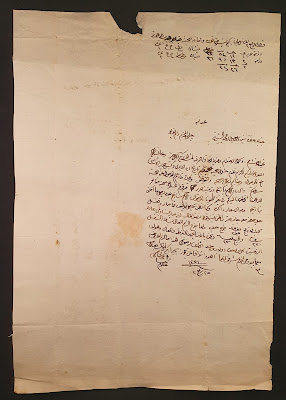The inscription looks like بركة محمد pronounced as Barakah Muhammad means blessing of Prophet Muhammad.
"Barakat Mohammed" is a sacred term for the inhabitants of Essaouira and you can find this inscription almost everywhere in the town.
The inhabitants of this town adorn their houses, shops, and building with this saacred inscription to invoke blessings.
The establishment of this type of tile dating from 18th century at the foundation of the town by the Sultan Sidi Mohammed Ben Abdellah al-Qatib ( Mohammed III c. 1710-1790), calling about divine protection of the town. He let build a fortress originally called Souira ("the small fortress"). Later the name was Es-Saouira ("the beautifully made, the picture") Today this town is called Essaouira.
 |
| Notice the "Barakat Mohammed" plate on the wall upper right (Souk el Jdid) |
Compare this inscription with the calligraphy in the 17th Century Quranic Manuscripts from Morocco :
Also compare with my other similar tile but for Jews and inscribed in Hebrew :
Artifact Specs :
Item : Marble Tile
Dim : 13.5cm x 13.5cm x 2cm
Date : 19th Century CE
Purchased Price :
Reference : Pottery from Morocco 19th-20th Century








